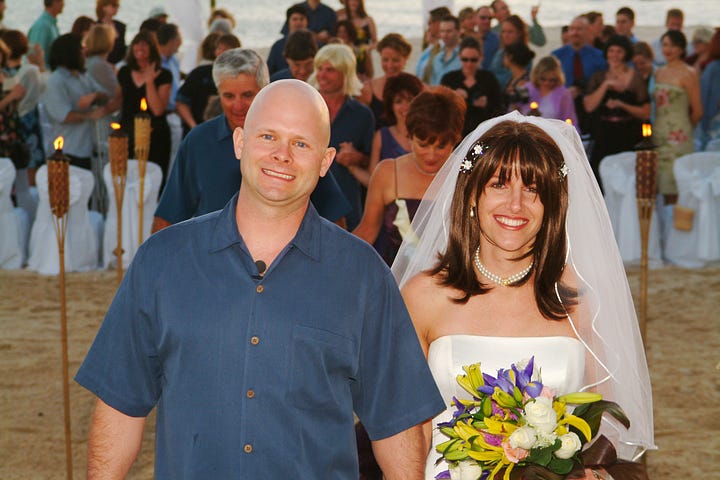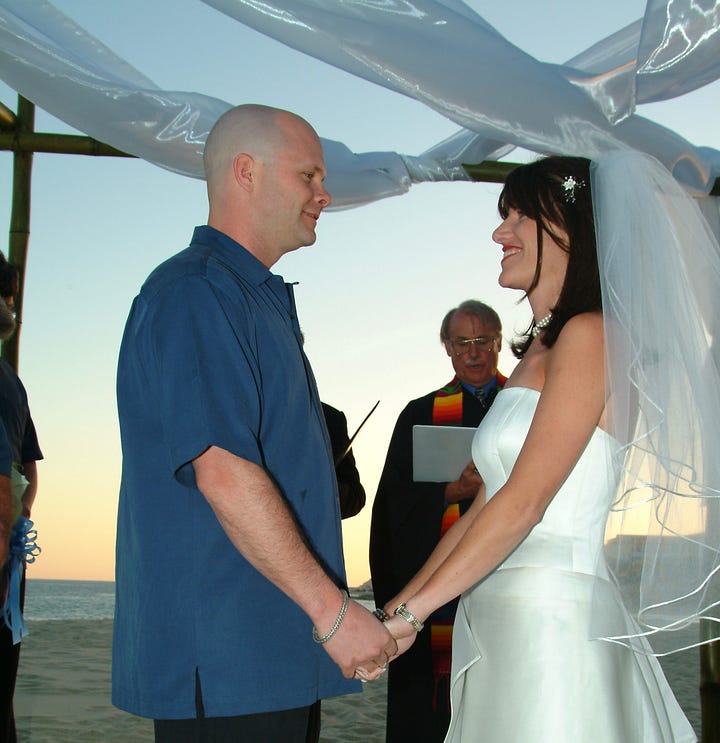A Love Story
They faced cancer together twice
Amid the rolling Pacific's backdrop and the highway's calming hum, Tracey and Thom marked two decades of marriage with a road trip along the scenic California coast. Their celebration was more than a milestone—it was a triumph of love over life’s hurdles. Tracey, having just successfully obliterated her second Stage 1 invasive breast cancer tumor in 2023, echoed the same defiant spirit she clung to twenty years before when the first tumor sought to unravel their just-begun forever. Here they were, love deepened with scars, proving they could navigate any storm together in 2003.
As their car hugged the twists and turns of the California coastline, it was hard to miss the symbolism in their journey. You see, twenty years ago, when they were just lovebirds itching to say "I do," cancer came knocking, uninvited. The diagnosis hit like a coastal fog—dense, disorienting, and threatening to obscure their vision of a shared future. But Tracey and Thom? They knew that their vows were more than words. They were survival tactics. And here's the kicker—they made it! Two decades on, their bond is the stuff of legend, the kind you tell when someone needs a little light to guide them through the darkness.
When she said 'yes' to Thom's proposal on Valentine's Day 2003, Tracey hadn't imagined wig shopping would be a part of her wedding preparations. The couple had a list of plans and dreams for their big day, but on November 12 of that year, life threw them a curveball. A small lump, initially dismissed by her doctors, was diagnosed as Stage 1, triple-negative, highly aggressive, invasive breast cancer roughly a month before her thirtieth birthday.
Given the nature of her diagnosis, her doctors prescribed chemotherapy. Tracey, hoping to retain some semblance of normalcy amidst the chaos, asked if chemotherapy could wait until after their wedding, three months away. The swift and unequivocal rejection of this request by her doctors brought home the gravity of her diagnosis. It was a chilling realization that underscored the immediacy and severity of her condition.
“It got real, real fast.”
Given the dismissiveness of the physicians involved before Tracey’s diagnosis, she and Thom sought a medical team in whom they could place their trust. They wanted professionals who would partner with them, educate them, and provide comprehensive answers to their queries, enabling them to make informed decisions.
“I remember how one surgeon described the difference between invasive and in-situ (Stage 0) cancer. He drew a picture on the exam table paper and said in-situ are juvenile delinquents, and invasive cancer is a career criminal.”
In the initial whirlwind of medical appointments with surgeons, oncologists, fertility specialists, genetic counselors, and the tumor board at Stanford, Tracey and Thom stumbled upon a clinical trial. This trial aimed to safeguard Tracey's ovaries by inducing temporary menopause through chemotherapy using a drug called Lupron. Fast forward two decades and this once experimental treatment became the standard of care for pre-menopausal women diagnosed with breast cancer, like Jacqueline at age 38. In this sense, Tracey was a trailblazer.
In addition to the Lupron trial, the couple participated in a pioneering Stanford fertility program designed specifically for cancer patients. This program sought to make embryo preservation more affordable for cancer patients should their fertility be compromised by chemotherapy, providing them with a safety net for their future family planning.
“The period between diagnosis and the start of treatment is as bad as it gets.”
A few months prior, Tracey and her fiancé, Thom, had completed an Ironman together. She was at the peak of her physical prowess, feeling invincible. They were deeply in love, their shared business was beginning to gain traction, and they were excitedly planning their idyllic destination wedding. Abruptly, their conversations shifted from wedding invitations and seating charts to discussions about fertility treatments and the handling of unused embryos.
As they began to understand all the components of Tracey’s treatment and decided to proceed with their wedding as planned, the timing of the interventions became critical. Tracey needed additional surgery to ensure clear margins. The fertility treatments and harvesting of eggs would occur while she recovered from surgery before starting chemo. Tracey, Thom, and their medical team meticulously coordinated to ensure their wedding date would be the off weekend between treatments. However, the Friday before her second surgery, the cornerstone of their carefully constructed schedule, Tracey received an alarming call from the hospital canceling her surgery. In a state of panic, they reached out to every doctor on their team but found no answer at 4 pm on a Friday, with most attending the ASCO conference in San Antonio. Undeterred, Thom managed to locate Tracey's surgeon, Dr. Jeffries, in her room at the conference's host hotel. He fervently implored her to help keep their plans intact. Dr. Jeffries reassured them, to their relief, promising that everything would proceed as scheduled.
“I found that at times during those early stages of diagnosis, I had somewhat of an out-of-body experience. These doctors were talking to me about me, and I remember feeling bad for the woman sitting there getting this information. It was a total disconnect. I was like, God, it sucks for her. She's, you know, so young and healthy, excited about her upcoming wedding, and now she has to deal with this. Poor thing.”
Tracey and Thom took an active role in her treatment and survival journey, seeking answers, collecting data, and making informed decisions about surgery, radiation, birth control, prophylactic options, and, ultimately, hormone replacement. In addition to the physical aspect, Tracey also concentrated on maintaining a positive mindset and regulating her emotions.
With guidance from the tumor board, Tracey and Thom opted to proceed with dose-dense chemotherapy using Adriamycin Cytoxan (AC) every two weeks for eight weeks, followed by Taxol every two weeks for another eight weeks. Tracey and Thom had their ‘wigs optional’ wedding at the halfway mark in treatment after completing AC and before starting Taxol. It was initially difficult for Tracey and Thom to manage her side effects, but after the first round of chemo, they developed a routine that made AC more tolerable. Luckily, Taxol was easier to handle. Despite their ordeal, Tracey recollects central joyful moments with friends coming over for game night the evening of treatment, their wedding, hikes, and runs she could complete on good days.
“Having to be so vulnerable and honest and talk about shit that nobody wants to talk about when they are young and in love made our relationship feel more substantial. It positively shaped our partnership. Nobody would choose to get married in the middle of chemo, but it was a very love-filled celebration. I've always been grateful for people showing up for us.”


Their wedding was a beacon of hope for Tracey, driving her through the challenging AC treatments. However, returning home from the joyous event was difficult, especially with their honeymoon to Fiji postponed and her next round of chemo only days away. The gloomy Bay Area winter only added to their melancholy. Thom arranged for a few newlywed days at the local Ritz-Carleton before Tracey's first round of Taxol to lift their spirits. Fortunately, Taxol proved more bearable than AC, with fatigue and steroid-induced acne being the most significant side effects.
After enduring the trials of chemotherapy and radiation, Tracey emerged victorious and ready to pick up where they left off. They booked their honeymoon for November and began asking questions about starting a family. They asked how soon they could begin trying to become pregnant. The standard medical advice was to wait 2-3 years after treatment. With Tracey now 30, Thom 37, and the couple lacking clarity on how many children they hoped to have, the waiting period was less than ideal. They asked for the reasoning behind the timeline. The response was that there wasn't a specific medical justification, but the recommendation stemmed from the heightened risk of recurrence in the years immediately following treatment, prompting social considerations. Tracey recalls the doctor compassionately explaining and saying, “Simply put, the concern is bringing a child into this world when the mother may not be here to raise it. You guys should talk about this before making any decisions.” When they did so privately, Thom tearfully said, “God forbid anything were to happen to you; I would want any part of you that could still be here.” Six months later, she and Thom joyously discovered they were expecting their first child and two years after that with their second. A happy sidenote to this part of their story was that they did not need the embryos they preserved and were ultimately able to donate all of the unused embryos to the UCLA Broad Stem Cell Research Center. Tracey and Thom hope their genetic material will make a difference in breast cancer and, more specifically, BRCA1 research.
A few months before her 50th birthday and their 20th wedding anniversary, Tracey found a small lump near her armpit on the opposite side from her initial cancer. Unfortunately, it turned out to be cancerous, requiring more surgery and another course of chemotherapy. It was not a recurrence. It was a new primary tumor and minuscule, akin to her previous experience. Unlike her first breast cancer experience, Tracey and Thom knew the vocabulary and felt they had a pretty good idea of what to expect. Tracey had prophylactic bilateral mastectomies 15 years prior and a complete hysterectomy three years after that, making the treatment plan clear-cut. She knew what she had to do.
As treatment progressed and her hair thinned, in January 2024, Tracey found herself back at the wig store in San Jose, where she had purchased a wedding wig in 2003 during her initial bout with cancer. They remembered her.
Tammy, the owner, recalled the encounter with Tracey 20 years prior. She recounted Tracey trying on a curly-haired wig in hopes of looking like herself on her wedding day and burst into tears as she said, "Oh my God, this looks like my hair on a bad hair day." That was not the wig she wore to get married.
Tracey mourns the losses inflicted by cancer, an unwelcome companion that irrevocably altered her life. The inability to breastfeed from her irradiated breast posed unforeseen challenges, with her unaffected breast, affectionately named 'Lefty,' working overtime to compensate. Lefty was noticeably larger than her irradiated breast, and she could only nurse each child for six months since pregnancy and breastfeeding make screening for breast cancer all but impossible. The mastectomies left a profound impact on Tracey's self-perception and stirred worries about Thom's perception of her. The subsequent hysterectomy further complicated matters, altering her experience of sexual pleasure. While Tracey is the first to admit that her experience with cancer was no picnic, she also believes it strengthened their partnership.
Tracey’s Tips:
Take time to find the right doctors
Slow down - give yourself time (weeks, not months) to digest the news, learn, and figure out the best approach
It will not be as bad as you expect
Control what you want people to know and be specific about what you do not like people to do - for example, don’t ask my children for updates on how I’m doing
Having a strong family history and electing not to get tested does not equate to doing nothing. Screen as if you are positive for the gene until you know otherwise
Happy Anniversary, Tracey and Thom. Let’s fly somewhere to celebrate your 40th.

